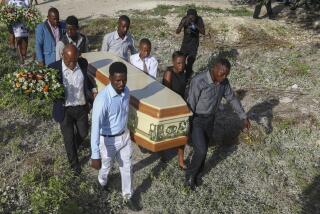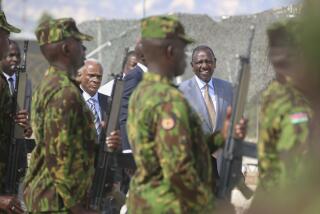Aid surge gets going in Haiti
Reporting from Port-Au-Prince, Haiti, and Washington -- The leading edge of a massive relief effort gained a toehold around the Haitian capital Friday, with the U.S. military taking control of the airport and helicopters ferrying supplies from an aircraft carrier positioned off the coast. But deep within the city’s neighborhoods, residents fended for themselves -- evacuating those who could go, caring for those who couldn’t and putting to rest those who would move no more.
Hundreds of doctors and aid workers and tons of supplies arrived at the airport, now teeming with traffic. U.S. officials said their goal was to land an aid flight every 20 minutes. Through the weekend, the U.S. military contingent assigned to the relief effort will grow to as many as 10,000, the officials said.
As aid poured in, those trying to distribute it faced the challenge of punching through mountains of rubble, smashed cars and streets strewn with bodies to reach a population clamoring for help.
Aside from a few police officers trying to control crowds at a gas station or direct traffic, there was virtually no sign of any authority in Port-au-Prince. The capital seemed remarkably calm three days after being devastated by a magnitude 7.0 earthquake, despite the growing frustration of people with no food, water or shelter.
Franz Solomon, 30, who was searching for the bodies of his mother and sister, still unburied two days after they were taken to the main morgue, was furious that he had nowhere to turn for help.
“The government can’t do anything anymore,” he said. “It doesn’t even exist.”
Scenes of desperation were everywhere, and the stench of death began wafting from beneath the broken concrete and flattened roofs.
The United Nations estimated that in the worst-affected areas of Port-au-Prince, as many as half the buildings were damaged or destroyed.
At one intersection, an elderly woman approached a vehicle, holding out a horribly burned right arm, skin charred and the hand swollen. With a bewildered look on her face, she asked where to go for help.
More than 100 members of the Army’s 82nd Airborne Division were in place. U.S. officials said the military deployment would include 4,000 to 5,000 sailors on ships, including the aircraft carrier Carl Vinson, plus 3,000 soldiers and 2,000 Marines on the ground.
Secretary of State Hillary Rodham Clinton announced that she would visit Haiti today with Rajiv Shah, director of the U.S. Agency for International Development, to see the relief effort up close. Clinton said she would meet with Haitian President Rene Preval and other officials and with U.S. authorities working to get aid to victims.
U.N. Secretary-General Ban Ki-moon said he would come Sunday. The U.N. appealed for $550 million to provide food, water and shelter to the victims. At least 37 U.N. personnel, part of a large, long-standing contingent in Haiti, were killed in the quake and 300 others still were unaccounted for, officials said.
Some aid made it through the obstacles. Water was being distributed from trucks in certain areas, a U.N. team distributed water-purification tablets, and French aid workers visited tent cities to see what people needed most.
Michelle Chouinard, Haiti director for Doctors Without Borders, said the group hoped to set up medical tents and perform surgeries. For now, though, its workers could offer only the crudest help: bandages and some floor space or furniture for the seriously injured.
Laura Blank of the aid group World Vision, which was expecting 18 metric tons of aid to arrive on a flight Friday evening, said that like most Haitians, the agency was having problems finding fuel.
“If we don’t have gas in the cars, we can’t get anywhere, and who has time to sit in a gas line all day?” Blank said as workers at the agency compound moved boxes of latex gloves and gauze as well as plastic bags containing clothes and hygiene supplies out of a warehouse where they had been stashed for hurricane season. The agency began distributing the items to nearby churches and clinics after the quake, and was one day away from running out.
Even the incoming aid, such as portable cooking kits and containers for water, would be of limited help if they could not find water to fill the containers, and the proper food for the cooking kits.
“The biggest crisis obviously is how do you get the resources all over the place?” said David Lipin of San Carlos, Calif., commander of the 40-member disaster medical assistance team sent in from California.
It was one of five such teams that arrived Friday afternoon, deployed by the State Department. About 250 doctors, nurses, emergency medical technicians, surgeons and even a couple of veterinarians were among those waiting to learn where they would be deployed -- and how.
There were still no reliable estimates of the number of dead, but some Haitian officials have said the number could exceed 100,000.
Officials and analysts said the speed with which aid is delivered will be key to preventing people from turning violent in their desperation -- at a time when Haiti’s government is almost nowhere to be seen.
Alex Puig, a security expert for International SOS, a Philadelphia-based risk management firm working in Haiti, said some violence was likely, despite the presence of U.S. forces. “It’s going to be a tough, long road, “ he said.
The scenes of devastation prompted Haiti’s deposed former president, Jean-Bertrand Aristide, to offer to return. Speaking to reporters in South Africa, where he lives in exile, Aristide said he felt a need to try to save the lives of victims, but he refused to take questions on whether he planned to fly to Haiti without an official invitation.
“We are ready to leave today, tomorrow, at any time, to join the people of Haiti, to share in their suffering, help rebuild the economy, moving from misery to poverty with dignity,” Aristide said, reading a statement in an almost inaudible whisper.
Aristide, 56, became Haiti’s first democratically elected leader in 1991 but was ousted in a coup led by the army later that year. He regained power in 1994 and was reelected president in 2000, before being toppled again in a violent 2004 coup. Aristide took asylum in South Africa but could still face legal charges if he returned to Haiti.
In the meantime, Haitians left to their own devices buried bodies where they could.
On the edge of the city’s cemetery along a once-grand boulevard, people heaved the dead into a 20-foot-deep mass grave, one of the makeshift burial sites popping up.
It held 60 bodies so far, and more were arriving every few minutes by wheelbarrow and in pickups festooned with logos such as “Love baby.”
Sanitation crews went through the streets, loading bodies into dump trucks. In a parking lot outside the capital’s main morgue, about 2,000 bodies lay in the sun, waiting to be identified and taken away.
Solomon circled the rotting mass looking for his mother. He had brought the bodies of his mother and sister two days earlier, but now realized they would end up in a mass grave unless he took them for burial. Amid the stench, he found his sister’s body and wrapped her in a bag. He couldn’t recognize his mother anymore.
The family of Elie Pierre, a pastor, survived -- as did his home. But like many Port-au-Prince residents, they had been sleeping outdoors in fear of new tremors.
On Friday, Pierre loaded about 10 members of his family into a small pickup to shuttle them out of the city. He planned to stay behind to find help for his 23-year-old daughter, Kesly, whose leg was broken during the quake.
Asked if he thought help was on the way, Pierre shook his head.
“I don’t believe anything right now.”
Times staff writers Tracy Wilkinson in Port-au-Prince, Robyn Dixon in Johannesburg, South Africa, and Ken Ellingwood in Mexico City and Paul Richter in the Washington Bureau contributed to this report.
More to Read
Sign up for Essential California
The most important California stories and recommendations in your inbox every morning.
You may occasionally receive promotional content from the Los Angeles Times.











